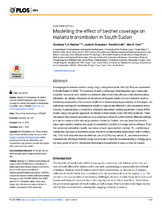Modelling the effect of bednet coverage on malaria transmission in South Sudan
Date
2018Author
Mukhtar, Abdulaziz Y. A.
Munyakazi, Justin B.
Ouifki, Rachid
Clark, Allan E.
Metadata
Show full item recordAbstract
A campaign for malaria control, using Long Lasting Insecticide Nets (LLINs) was launched
in South Sudan in 2009. The success of such a campaign often depends upon adequate available
resources and reliable surveillance data which help officials understand existing infections. An
optimal allocation of resources for malaria control at a sub-national scale is therefore paramount
to the success of efforts to reduce malaria prevalence. In this paper, we extend an existing SIR
mathematical model to capture the effect of LLINs on malaria trans- mission. Available data on
malaria is utilized to determine realistic parameter values of this model using a Bayesian approach
via Markov Chain Monte Carlo (MCMC) methods. Then, we explore the parasite prevalence on a
continued rollout of LLINs in three different settings in order to create a sub-national projection
of malaria. Further, we calculate the model’s basic reproductive number and study its sensitivity
to LLINs’ coverage and its efficacy. From the numerical simulation results, we notice a basic
reproduction number, R0 , confirming a
substantial increase of incidence cases if no form of intervention takes place in the commu-
nity. This work indicates that an effective use of LLINs may reduce R0 and hence malaria
transmission. We hope that this study will provide a basis for recommending a scaling-up of
the entry point of LLINs’ distribution that targets households in areas at risk of malaria.

